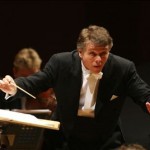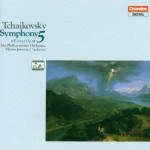Recording The Tchaikovsky Symphonies|Part One
During my fifteen-season tenure as timpanist of the Oslo Philharmonic, I had the honor to participate in over forty recordings with the orchestra for the following recording labels: Chandos, EMI/Angel, Sony Classical, and the Aurora label as well as the Norwegian Cultural Council. Most of these were conducted by our chief conductor, Mariss Jansons, although we recorded under the baton of other conductors in recording for Sony, and the Norwegian Cultural Council (which released their recordings on the Aurora label).
The focus of this post is on the Tchaikovsky cycle that we eventually recorded and released on the Chandos label. How this came about and the results make for an interesting read, and I hope that the reader will bear with me during the telling. I started to tell a bit of the story in my previous blog post (My Musical Career – Part Twenty-Six), but that was in the context of my overall musical story. I can go into more detail here. Here goes!
How the project got started
The project was a result of the desire of our chief conductor Mariss Jansons’desire (which was shared by the orchestra) to not only record contemporary and standard Norwegian music literature with the orchestra, but the standard literature as well. The problem was partially solved with the recordings undertaken by the Norwegian
Cultural Council, of which the Grieg series was an integral part, as well as the recording of Finn Mortensen’s Symphony. Most of the Grieg series was completed by the time I arrived on the scene, and the Mortensen symphony was recorded in the final season of my predecessor, Knut Fjeldhøi.I knew that discussions were taking place between Mariss and the administration, as well as the program committee. The biggest obstacle was the lack of any interest from the major recording labels of the time, namely DGG, EMI, Philips, etc. in recording the orchestra.
At this time, the orchestra was looked upon as a very good Scandinavian ensemble, one of many. We had not attained any visibility on the world music stage. Mariss had a good reputation among young European conductors, but was just beginning his rise to critical fame. His desire was to take the orchestra with him on his rise, and recording the standard literature with “his” orchestra would be an excellent calling card.
After many discussions it was decided to bite the bullet and make a recording at our own expense of a major symphonic work. The orchestra would have to in effect donate their services and record this work for free. After the program committee voted to go along with this idea, it had to go before the members of the orchestra at an orchestra meeting, held in the concert hall just after a regular rehearsal. The idea was presented to the membership, and after a spirited discussion, was agreed to.
Setting up the first sessions
Having received the go-ahead from the membership, it was now up to the administration. Terje Mikkelsen, who was operations manager at the time, was one of the prime movers of the project. He did a lot of the grunt work in researching who would be the best recording producer, and in negotiating with NRK (Norwegian Broadcasting) for the use of their recording engineer and facilities. Without his energy and devotion to his job, I doubt seriously if it would have happened at all.
After extensive investigations, Terje recommended that the orchestra hire James Burnett, a renowned British independent recording producer to perform that task for us. Egil Johan Damm, then our regular
NRK recording engineer would assist. As it turned out, they made a great team. James Burnett was
a thorough professional. He had produced classical recordings with major orchestras and recording artists for many years, and preferred to work as an independent. His understated but affable personality was perfect for working with Mariss, and he was greatly respected by the orchestra. Egil Damm was an extremely competent recording engineer for the NRK, and he knew the ins and outs of his job as well as the tricky acoustics of our venue quite well.
The dates for the recording sessions were set for the end of January 1984, if memory serves correctly. I believe we devoted two three-hour sessions to the project. One of these was a Friday morning, and the other was the next morning, a Saturday.
It was now up to the orchestra to do its part.
Getting the orchestra (and instruments) ready
Mariss had chosen (and the orchestra agreed) Tchaikovsky’s Symphony No. 5 in E minor as the work to be recorded, and the since the orchestra had not played the work in concert for some time, devoted a series of rehearsals in order to get it in shape for the recording sessions. He was as usual, quite thorough, and rehearsed as if it was to be performed in concert. The result was outsanding.
At the same time, I had to do preparation of my own. I had to re-learn the part , even though I had performed it several times already (albeit with other orchestras). I thoroughly combed through the part, and made sure that I was conversant with all of the potential trouble spots (the first movement has its share), and when that was done, it was time to make sure that my equipment was up to snuff.
When I arrived in Oslo for the first time, the Hinger timpani were equipped with clear Remo heads – at least the four larger drums were. The 20 inch timpano still had its original hazy Remo head, but this drum would not figure in these recording sessions. I was not able to do anything about the drums until after I had won the audition and started my tenure; I had concluded to replace the heads with Remo hazies when and if I returned to Oslo as the permanent timpanist. As soon as I started with the orchestra, I discussed the situation with the management, and was able to order a set of Remo hazies for the four larger Hinger drums.
I was hoping to get them on the instruments several weeks ahead of the recording sessions in order to give the heads a chance to be “played in” and to get used to them. I preferred then, and still do, the hazy heads to the clear Remos as I felt that the hazies gave a warmer sound, which is what I preferred.
In the event, the heads arrived inn early December, just enough time to get them on the instruments and play them in for a couple of concert series and the first two weeks in January. During the Christmas holiday I made several trips to the hall to practice and “play in” the heads.
By the time we started rehearsals for the project, the drums were in god shape and sounding the way I wanted them.
For mallets, I chose from a set of Hinger wood shafted general, medium hard and hard mallets, and a set of Andrew Feldman generals. The rehearsals proved useful in deciding what I would use for the actual recording sessions. I chose these from a much larger collection of Hinger and Feldman mallets. I concluded that the wood-shafted mallets would record a little bit better than the regular aluminum shafted mallets (which I liked better). Part of the problem was they projected a little too well for the microphones, so I had to adjust and use the wood-shafted mallets instead.
The recording sessions
The sessions were held on January 26 and January 27th, 1984, having used the previous few days to rehearse. This saved much time, and by the time we started on the 26th, we were able to record each movement straight through at least twice, and use the last hour for splicing. As I mentioned in an earlier blog, these were the first sessions in which the musicians were allowed to enter the control room and listen to the playback of the material we just recorded. Mariss sat at the control desk, with Jimmy Burnett, the producer on one side, and Egil Damm on the other. We musicians stood in a group just behind them. The music was played back on B and W speakers of the latest design, and the sound was quite excellent. Mariss ‘s attention was on the score in front of him and in listening to and following the music, making notes of what he didn’t like and what he did. Occasionally, he’d turn to the musicians and discuss certain points of the score with those of us who were relevant to that particular passage.
Most of the symphony was “in the can” by the middle of the second session on Saturday, the 27th. The last hour or so was spent on recording short snippets of sections that could have gone better for later splicing and editing.
This was a whole new experience for me, as I had to adjust my style of playing for the microphones. I had to play a bit softer than I was accustomed to, but yet user slightly harder mallets thn I would normally use in order to guarantee the right amount of articulation. This is a hard thing to do, and especially with the quirky acoustics of the Oslo Konserthus, quite difficult to bring off. I was fortunate in the fact that I could equipment and mallets, and a sympathetic producer. James Burnett was quite familiar with the acoustics of the hall, and totally agreed with us that they left a lot to be desired. Jimmy (as he was known in the industry) and I had several discussions about this very subject, and he advised me to just play as I normally would, subject to Jansons’s control, and he would take care of the rest. For the third movement, I actually used the hardest of the Hinger wood-shafted mallets
As I make this entry, I am listening to the CD of the symphony, and marvel at just how well the orchestra played, and how well Jimmy was able to make a marvelous artistic result of the whole. But I am getting ahead of myself here. We had to wait several months to see if it would even make it to disc as there was still no buyer for the recording and no one to release it.
The waiting
As it turned out, it took nearly four months of contacting the various recording companies, namely Decca, EMI/Angel, Phillips, Sony, and DGG. Terje Mikkelsen was shuttling back and forth between each of these companies and not having any luck. He then tried the smaller companies, with no result. However, when he visited the offices of Chandos
Records, Ltd, he was given an opportunity to play them the recording. Brian Couzens, the founder and Managing Director of the company as well as chief recording producer was bowled over. He told Terje that he had never heard such a committed performance. He was prepared then and there to make an offer to record the entire cycle.Of course, all of us were over the moon when we heard the news, and negotiations began to lay the groundwork for the complete cycle. The 5th Symphony would be released on LP in the fall, just before the next installment in the cycle, which would be the 4th Symphony. Of that, more later.



Recent Comments